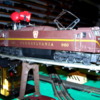The kits came with an adaptor plate for use with the dummy truck when a single motor setup was installed.
I think the adaptor plate is held in by four screws.
Just remove the plate, and install a second motor.
Those motors have two flat mounting posts. These posts fit into slots in the chassis.
Place the motor on the frame. A cup washer is put over the posts (flat side towards the frame), followed by a spring, and finished with a tinnerman's clip to hold everything together.
I have a block that fits between the wheels to support the motor while setting the tinnerman's clip.
I use a socket of appropriate size as a tool to drive the clip in place.
I rap the back of the socket with a soft tipped hammer.
I like to put the clip on just enough to lock in place.
If you drive it further, that's OK as long as the motor swings and can rock.
If things are too tight, you may have issues with derailments.
(Not a big deal, just remove the clip and try again).
I don't try to reuse the clips.
The Train Tender sells them for 15 cents each when you buy a minimum quantity of twentyfive.
Wiring should be straightforward.
Connect the power wires from rollers on both trucks together.
Connect a jumper wire between the fields.
Connect jumper wires between the brush holders.
The brush holder wires should go parrallel to the edge of the frame.
This will make the motors run in opposite directions when viewed from the coupler end of the motor (towards the coupler versus away from the coupler), but that is what you want.
If they don't run to work together, just exchange the wires on one brushplate.
One last thought:
I would try to find as close of a match as possible for the second power truck.
There are variations in the construction of the MPC Geep power trucks. For example, older trucks do not have a set screw on the brushplate. Some MPC power trucks have a pointed set screw, which can wear a dimple into the top of the armature shaft. When the dimple gets deep enough, it can slow down the motor a bit.
I've replaced those pointed set screws with flat ones to eliminate the issue.









